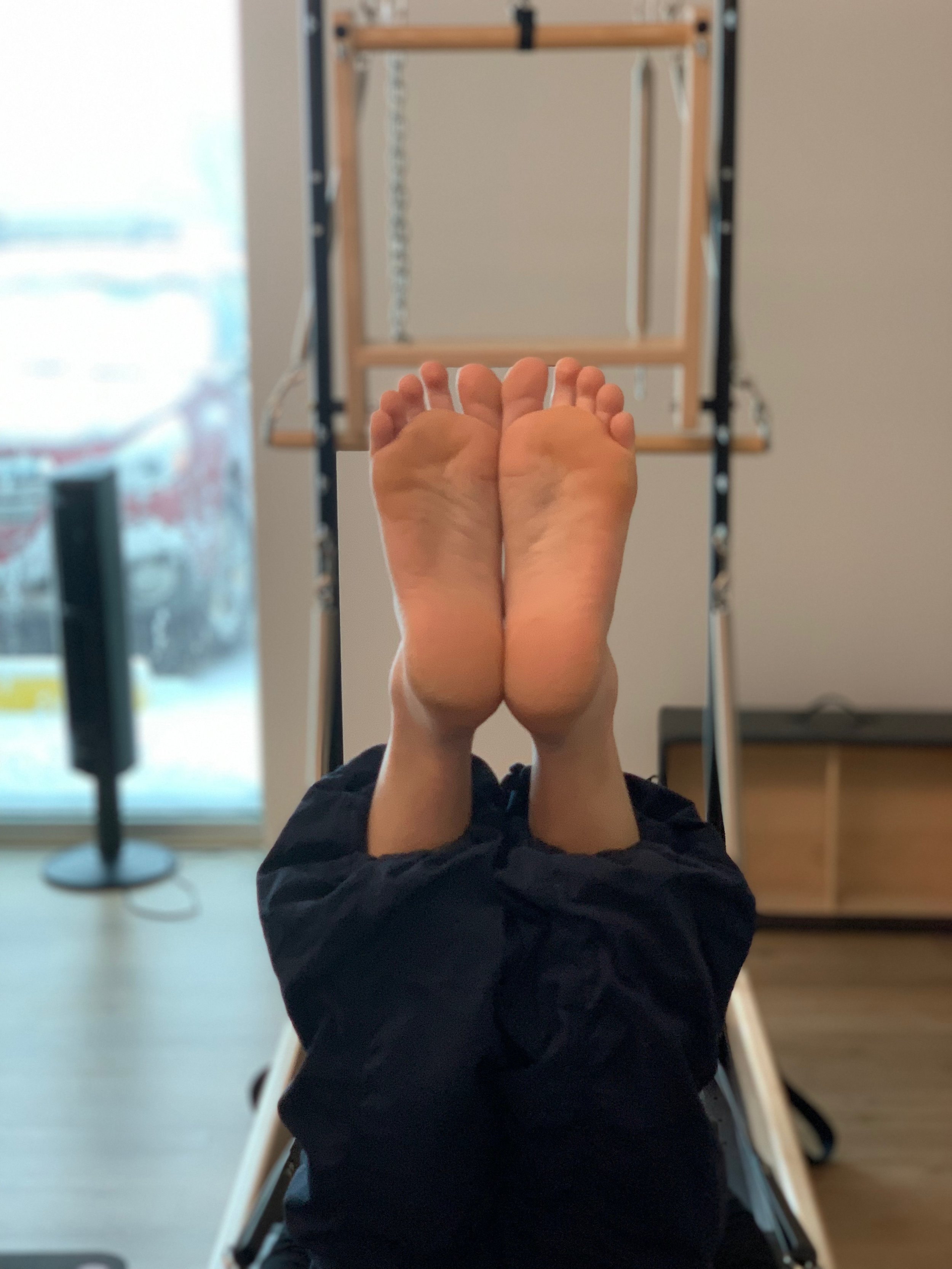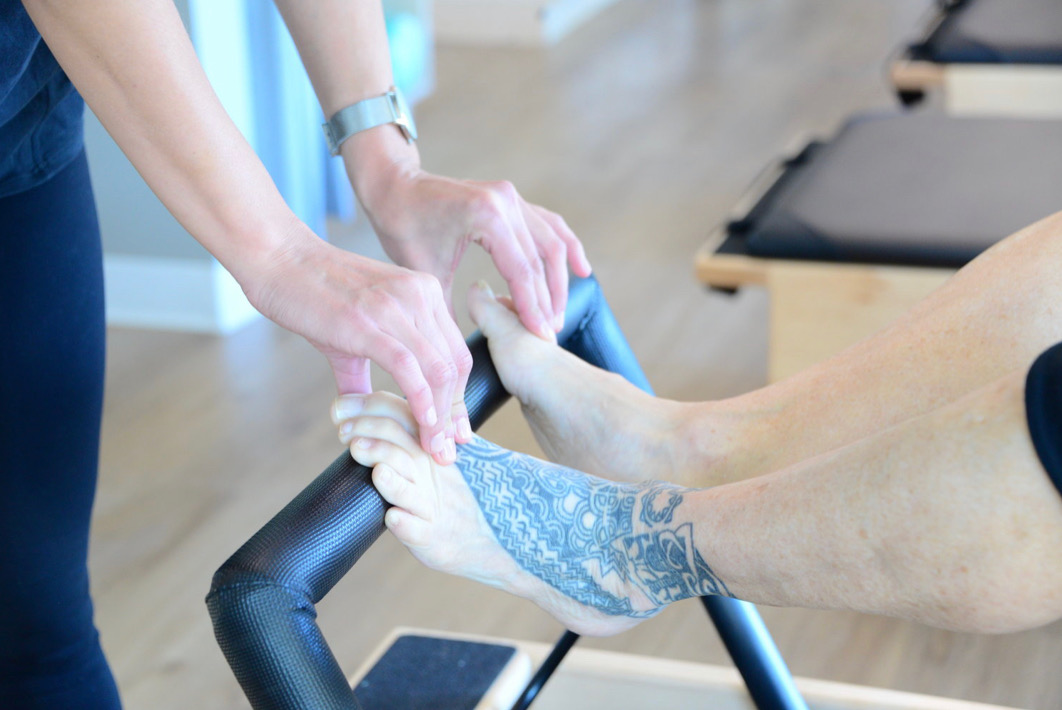Focus on Your Feet with Ann Daxberger
When Pilates instructors ask clients what they want to focus on in class, the answer is typically arms, abs, legs, or back. The one thing we rarely hear—but perhaps should—is feet.
Ann Daxberger has been teaching Pilates for about 18 years. A few years ago, to supplement her education and deepen her understanding of the body, she completed Katy Bowman’s Restorative Exercise certification. This is when she first realized the power residing in our feet.
“There are 33 joints in the feet,” Ann explains. “There are more joints in your feet than there are in your spine.” The 33 joints, 26 bones, 107 ligaments, and 19 muscles in the feet do a lot more than many of us realize. When our feet have issues, the effects travel up the rest of the body. And yet we rarely give our feet the attention they deserve. Ann seeks to change that.
“I’m a firm believer that people need to be walking barefoot,” Ann says. Although shoes may protect the soles of our feet from hazards in the environment, they’re also doing us a disservice by impeding sensory perception. Our feet have somewhere in the neighborhood of 8,000 nerve endings. When walking barefoot, these nerves feed our brain information about the ground beneath us: its texture, temperature, and stability. The muscles and joints in the foot respond with articulation, and the rest of our body reacts accordingly in order to keep us stable. There are two primary benefits to this.
One, this movement allows the numerous joints of the feet to stay active, which keeps them supple and mobile. “If you don’t move a joint, it fuses,” Ann says. “Your feet should move like your hands.” This level of dexterity in the feet is something most of us may only dream of, but walking barefoot is a sure way to work towards it (as is the massage suggested near the end of this post).
The second advantage of walking barefoot is that it helps preserve balance. Our muscles, starting with those in the ankle and lower leg, engage in a nuanced way based on the information detected by the soles of the feet. If our foot feels something sharp, our leg will respond by shifting so we don’t put all of our weight onto a sharp object. If we start to lose our balance, our muscles will react in an attempt to bring us back to stability. These responses are so automatic and immediate that it’s difficult to even notice them.
To tune into these reactions, here’s a quick experiment.
Stand barefoot near a wall or surface you can use for balance (but do your best not to rely on it). Shift your weight to the outer edges of your feet, then to the inner edges, to the toes, and to the heels. Do this slowly several times, noticing how the muscles in your legs and hips respond accordingly to help you keep your balance. In particular, note how muscles around your ankle and shin activate and release. You can feel this even more acutely by doing the same thing with only one foot on the ground.
When we consistently protect the soles of our feet with shoes, especially those with thick soles, we deprive our body of information vital for balance. After an extended period, this can lead to the loss of muscle memory and tone that helps us maintain balance, which weakens our first defense against falling. Especially as we age, the risk of injury escalates greatly.
To preserve your body’s natural mechanisms for maintaining balance, Ann recommends walking barefoot regularly, working your feet daily, and transitioning away from thick-soled shoes and towards shoes categorized as “zero drop.”
Every shoe has a “heel to toe drop,” often simply called a “drop.” The drop of a shoe is the distance between the heel’s height and the height of your toes. For instance, if your shoes have one inch of padding underneath the heel and a half inch of padding underneath the toes, the drop of the shoe is a half inch. The drop of shoes like high heels and wedges are quite obvious, but even shoes that are marketed as beneficial for our bodies can have a drop. In fact, many athletic shoes have some measure of drop.
When wearing shoes with a drop, the shoe shifts more weight into the toes, causing the body to pitch forward. In response, the quads engage and the hamstrings release, which affects the alignment of the pelvis (as well as the rest of the body). Repeated engagement of the fronts of the legs and lack of engagement of the backs of the legs trains the body to remain in this alignment. Over a long period of time, this can cause the hamstrings and glutes to weaken, which is a frequent contributor to back pain (some of which might have brought us into the Pilates studio in the first place!). In extreme cases, a drop may even physically push the foot forward against the front of the shoe, which is problematic for the toes.
The optimal shoe, for our feet and for our alignment, is one with no change from the height of the heel to the height of the toes—a “zero drop” shoe.
According to Ann, zero drop shoes are the most optimal form of footwear. If you’re used to wearing shoes with a drop, immediately switching to zero drop shoes can be jarring and might even cause back pain. To ease your body through the transition, Ann recommends wearing shoes like Altras in which you can gradually work your way from a higher drop to a lower one. Once you’ve transitioned down to zero, Ann suggests a Boulder-based shoe brand called Lems.
Along with wearing the proper footwear, Ann advocates for working your feet daily.
Try this massage sequence:
Seated on the floor or in a chair, bring your left foot up where you can reach it. Take the fingers of your right hand and thread them between your left toes. It might be hard to get them in between, but give it a try. Squeeze your toes with your fingers, then release. Do this 3-5 times. Then squeeze your fingers with your toes and release. It might hurt! Breathe and repeat 3-5 times. Keeping your fingers between your toes, roll the ball of your foot in a circle both directions. After you release your fingers, massage the sole of your foot, kneading the arch, heel, and outer edge. Before switching to your other foot, stand up for a moment to feel the effect. How does your left foot feel different from your right?
Doing this once a day, even quickly, is a great way to maintain mobility in your feet.
Ann has many more tools in her repertoire for keeping our feet healthy and mobile. She’ll be sharing them this Saturday, March 16 during her Focus on the Feet workshop. The workshop is now full, but stay tuned to our blog and Instagram for takeaways on how the feet affect the rest of the body and ways you can keep them well.
With all the work our feet do for us, it’s high time we give them some love in response.
Have questions about your feet, or any other part of your body for that matter? Contact us! We want to hear how we can empower you to feel your best.



